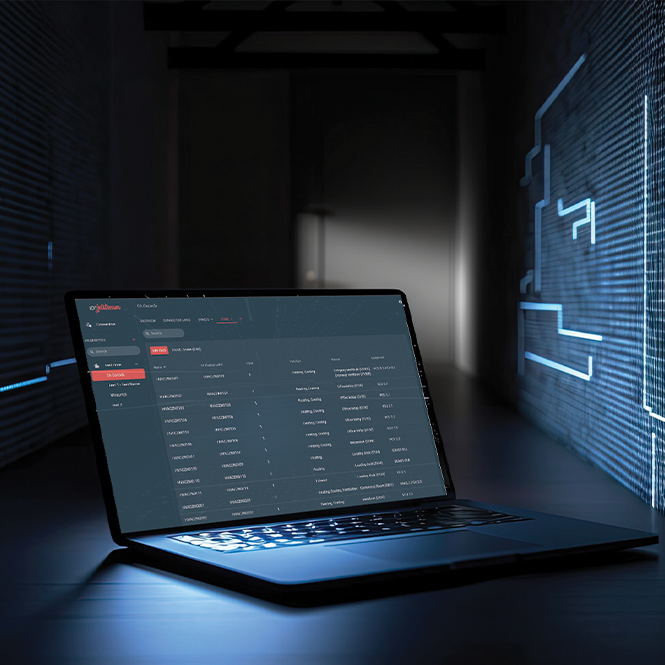"We shape our buildings, thereafter they shape us." — Winston Churchill

Solution
Data accessibility for building management workflows

IOT Jetstream makes building data accessible no matter where it comes from. The GraphQL API provides engineers, operators and developers a unified and standardized source for historically hard to handle time-series data. This means data from any system in any building across your portfolio looks the same everywhere you go.
What’s in a name?
What’s in a name?
A user can query for Zone Temperature in 1 building or 1,000 buildings and the result will always be Zone Temperature.It’s 5 o’clock somewhere
It’s 5 o’clock somewhere
Occupied Hours can be analyzed across time zones, regardless of sensor manufacturer.Normal for the win
Normal for the win
Energy consumption metrics can be automatically normalized for square footage and weather.
Varied visualizations
Varied visualizations
Third party developers can pull historized, time-series data into their own applications to visualize in any way they please, without having to negotiate network connections or BACnet configurations.
Time to value
Time to value
Software teams can write integrations between tools to share data across systems in less than a day.
Connectivity
Compatible with cutting edge and established data connectivity types: Pull (API, Niagara, SkySpark, BACnet) and Push (MQTT, Webhooks, Firehose).
Support for multiple Ontologies (Haystack, Brick, DBO) and Standards (UDMI, Sparkplug).
Large number of OEM providers.
Integrations to hundreds of systems and thousands of equipment.
Time-series point data collected in real time and historized at a fraction of the cost of data lake solutions.

Frequently Asked Questions
What is adaptive connectivity?
Adaptive connectivity enables people to get massive amounts of equipment and data into the IOT Jetstream data layer directly and at scale. Bi-directional communication – known as writeback in the framework – is also a capability of this functionality. It is built on an event-driven infrastructure that allows data-producing devices to push their data directly to the Jetstream API where it is modeled and normalized for application consumption.
Will adaptive connectivity only discover a device when the device has an event? How does the device know to push to the data layer?
etstream does not discover devices. During the setup process, known devices or gateways are configured with credentials and an endpoint. This allows them to connect to our MQTT broker. Whenever something happens within a device, the device knows to publish a message to the broker. An example of this could be something like a change of value for a temperature reading. Jetstream’s adaptive connectivity listens for these incoming messages and processes them in real time as they arrive.
Why is Buildings IOT investing in this development effort?
The event-driven messaging framework represents a significant new option for how we acquire building data, changing from a “pull” basis where we ask in-building devices to send us data on regular intervals to a “push” basis where equipment sends us the data directly every time there is an event at the device. This means we can process data faster and with fewer intermediaries. This framework eliminates the need to create a new connector for every new data source.
What changes for IOT Jetstream as a result of this development?
Adaptive connectivity allows integrators to bring in hundreds of buildings worth of data just by giving direct access to devices. This significantly reduces onboarding time and therefore integration costs while simultaneously increasing the amount of data we can bring into our system. It also speeds up our end-user systems and enables more flexible front-end features.
How does adaptive connectivity change the deployment process?
As with all aspects of the Buildings IOT onboarding process, technical details and step-by-step instructions are provided to all onboarding employees and partners via the Buildings IOT Help Center. The utilization of this connectivity option requires people in technical roles to understand how gateways communicate with MQTT brokers.
Additional onboarding tooling for this connectivity method is in development and will be made available via the IOT Jetstream user interface when complete.
Does this mean the Buildings IOT LaunchPad is no longer required?
The adaptive connectivity method is available to customers as a connectivity option like BACnet and Niagara 4. It is possible that a single building could contain multiple connectivity types – BACnet and MQTT, for example. The connectivity method will be determined between Buildings IOT and the customer during the solution design and architecture phase of proposal development. LaunchPad will remain a supported method of data acquisition and will likely expand to include additional supported connectivity options.
Is IOT Jetstream and adaptive connectivity sold as a standalone product or as an add-on to Jetstream and/or onPoint?
The adaptive connectivity option is available through Jetstream as an additional method of connectivity to device-level data. There is no additional charge to utilize this method of data acquisition. Connectivity determinations will be made during the sales process with support from Solution Architecture. There can be multiple methods of connectivity for a single building, and definitely across an entire portfolio.
Does a customer choose either Jetstream or LaunchPad, or can they choose neither?
Every customer requires connectivity from their site to our cloud. This can be accomplished via LaunchPad or other gateway to IOT Jetstream, or both but not neither. For example, an HVAC system could be connected via BACnet to LaunchPad while air quality and occupancy sensors are connected via LoRa Wan gateway to JEDI. Once connectivity is achieved and data is acquired, it all ends up modeled and available in Jetstream.
Success stories
See it for yourself: discover real-life onPoint's success stories.

Macerich, a leading real estate investment trust, faced challenges in reducing energy consumption...

Facilities within higher education institutions often face the challenge of integrating complex...

Santa Clara, CA-based software company leverages smart building integration technology to solve...

Macerich creates an enterprise energy management solution with command and control capabilities and...

How STACK Infrastructure achieved zero downtime redundancy for high-end data center management...

STACK Infrastructure integrates mechanical equipment and energy power monitoring to create a truly...

Leading mall operator champions demand management in Texas. The Woodlands Mall is a bi-level,...

Analytics and preventative maintenance help the University of Melbourne achieve carbon neutrality...
Are you ready to turn your building data into action?
Let’s talk about how you’d like to use your operational data to reduce operational expenses, achieve energy savings, reach climate impact targets, comply with local laws and many more use cases.






